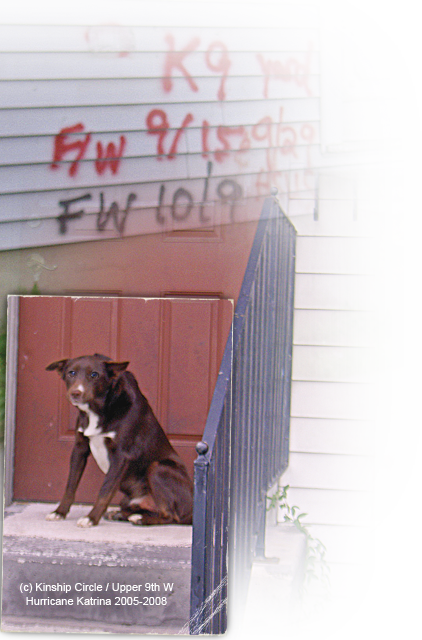Katrina Stories


Left-Behind Dogs Of New Orleans
Life And Death On Toxic Streets
by Michael Brick, The New York Times
9/20/05, Workers Try To Rescue Animals Abandoned In New Orleans ~ Up North Claiborne Avenue five dogs ran as a pack between the smashed houses under dead power lines, through that twisted junkscape of lumber and tin, toilets in the silt, a wall marked "Possible Body" and the headless Virgin Mary with arms outstretched. The dogs neither fought nor growled. Among their number were a German shepherd, a beagle and a yellow Labrador.
They roam this city gaunt and uncomprehending, at turns frightened and menacing, loping directionless between ruined buildings, drinking the muck, staring at cars, waiting to die. They are omnipresent. A week ago, their self-appointed rescuers spoke of the odds of rejoining them as pets to masters, but that talk has ended. Now these dogs make for an infestation, untold thousands unwell, unrestrained, unrecognizable and left to their devices.
"I'm afraid that they will be out here for years," said Wendy Guidry, among those who spend their days trying to corral the creatures.
"There will be a long-term population of dogs who will never be caught, who will live on the streets for years and eventually be hit by cars. That will be their lives."
The dogs do not lack for sympathy or attendants. From the first days after Hurricane Katrina laid waste to this city, images of pets that were left behind despite protestations drew crowds of rescue volunteers. Money was gathered and airlifts were chartered.
Among the crowded flights bound for New Orleans when Louis Armstrong Airport reopened last week, on planes full of cowboy contractors and corporate fixers, the earnest came to save the dogs. On a connection out of Atlanta, Crystal Smith made the first flight of her life to come join the Humane Society here. She was afraid of the dogs she would find.
"They're becoming vicious," Ms. Smith said. "But it's not because they're hungry and they want to eat people. They're scared. They're stressed out; they've been living on the roof. And they don't know what you're here for."
More than 400 rescuers are based at the Lamar-Dixon Expo Center in Gonzales, La., 60 miles away, said Julie Morris, director of national outreach for the American Society for the Prevention of Cruelty to Animals. With credentials from New Orleans, they enter the city to chase animals, and they have captured about 7,000.
How many remain no one knows. Based on human demographics, American Veterinary Medical Association estimates that 50,000 to 70,000 dogs were kept as pets in New Orleans. "Nobody knows how many people evacuated with their animals," Ms. Morris said.
That leaves pets abandoned in the evacuation of the city, the feral population and the pit bulls trained to fight for sport, a significant pastime here before the storm. Rescuers on the streets said the bigger dogs were dying first.
"We were seeing dogs eating dead dogs," Ms. Guidry said.
Those removed from the city are increasingly diseased. Sixty have been euthanized in Gonzales. "The longer it goes on, the worse that's going to get," Ms. Morris said.
On the streets, though, the dogs are learning to survive. Rescuers, soldiers and journalists leave the dogs food, and sometimes the food is gone when the people return. Rescuers have found dogs cowering in houses, but many dogs, called runners, remain on the streets.
A few blocks away in the Ninth Ward, where packs gather by a breached levee, three German shepherds patrolled a smashed wooden rooftop in the tall grass. When two men approached, the dogs ran to the near edge of the tar-black rooftop four feet from the ground. They raised their heads and craned their necks and barked hoarsely into the quiet.
The men poured crackers onto the street outside the twisted fence, and two of the dogs barked. The third returned to the high point of the roof, where he could see the broken levee, and laid his head on the tar.



